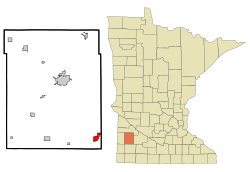Tracy, Minnesota
| Tracy, Minnesota | |
|---|---|
 Location of Tracy, Minnesota |
|
| Coordinates: 44°14′N 95°37′W / 44.233°N 95.617°W | |
| Country | United States |
| State | Minnesota |
| County | Lyon |
| Government | |
| • Type | Mayor – Council |
| • Mayor | Stephen J Ferrazzano II |
| Area | |
| • Total | 2.23 sq mi (5.78 km2) |
| • Land | 2.18 sq mi (5.65 km2) |
| • Water | 0.05 sq mi (0.13 km2) |
| Elevation | 1,391 ft (424 m) |
| Population (2010) | |
| • Total | 2,163 |
| • Estimate (2012) | 2,142 |
| • Density | 992.2/sq mi (383.1/km2) |
| Time zone | Central (CST) (UTC-6) |
| • Summer (DST) | CDT (UTC-5) |
| ZIP code | 56175 |
| Area code(s) | 507 |
| FIPS code | 27-65308 |
| GNIS feature ID | 0653262 |
| Website | www.tracymn.org |
Tracy is a city in Lyon County, Minnesota, United States. The population was 2,163 at the 2010 census.
U.S. Route 14 serves as a main arterial route in the community.
According to the United States Census Bureau, the city has a total area of 2.23 square miles (5.78 km2), of which 2.18 square miles (5.65 km2) is land and 0.05 square miles (0.13 km2) is water.
Tracy was platted in 1875. It was named for John F. Tracy, a railroad official. A post office called Tracy has been in operation since 1877. The city was incorporated in 1893.
On June 13, 1968, Tracy was hit by an F5 tornado which killed 9 people and injured 150. Until the 1960s, Tracy was a highly active railroad town on the Chicago & Northwestern Railway as a concentration point for numerous branchlines in the area serving heavy agriculture. Today, Tracy holds an annual summer festival called "Boxcar Days," which takes place Labor Day weekend as a sign of the railroad's influence on the town. Currently, Tracy is still a division point on the Canadian Pacific Railway (formerly the Dakota, Minnesota and Eastern Railroad), where railroad crews from both east and west exchange trains.
As of the census of 2010, there were 2,163 people, 876 households, and 549 families residing in the city. The population density was 992.2 inhabitants per square mile (383.1/km2). There were 1,032 housing units at an average density of 473.4 per square mile (182.8/km2). The racial makeup of the city was 86.5% White, 0.1% African American, 0.3% Native American, 9.7% Asian, 0.1% Pacific Islander, 1.5% from other races, and 1.7% from two or more races. Hispanic or Latino of any race were 5.4% of the population.
...
Wikipedia
